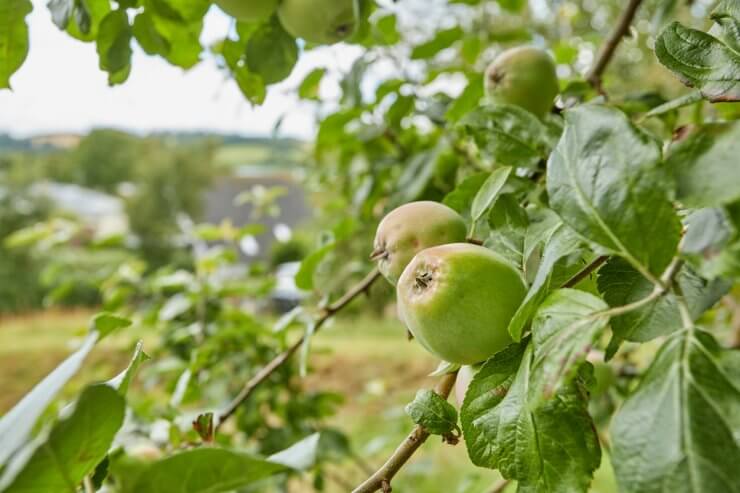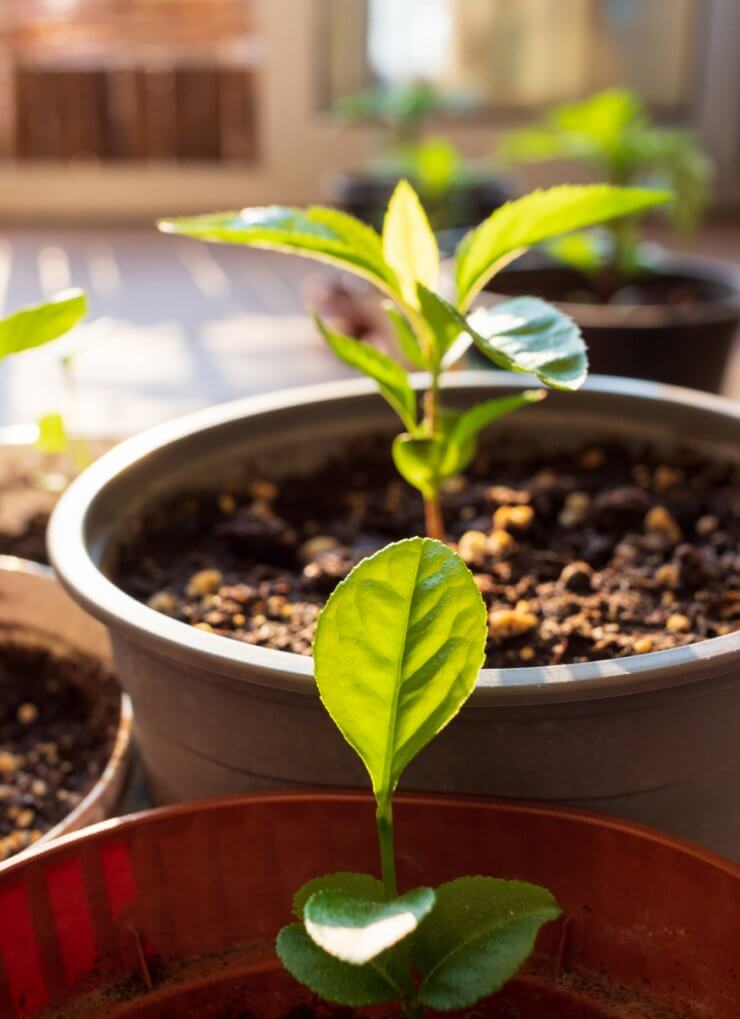
Fresh apples on an apple tree in the garden
Apple trees love sunshine and fertile, well-draining soil. They like a soil pH between 6.0 and 7.0. They need full sun in order to thrive; it’s essential to the growth of good quality fruit. Full sun—six to eight hours of sunlight during the growing season—also helps keep fungal issues at bay.
When you’re scouting out a site to plant your apple trees, make sure there are no big leafy trees nearby that will block the sun. You also want to make sure that your soil has good drainage. It’s a good idea to get your soil tested before you put any new plants into the ground, but especially so with apple trees. Soil that has too much clay will give your trees soggy roots. Fast-draining, sandy soil can induce drought-style water stress. So, assess your soil and amend it before you welcome your new trees to your land.
We say trees, plural, because most apple trees are not self-fertile, so they need a pollination buddy tree that flowers at the same time (all or at least part of the time). That cross-pollination will help ensure a healthy apple harvest. Plan your planting to accommodate at least two trees. They don’t have to crowd each other. They need to be spaced at least as far apart as fully grown trees, but within 50 feet of each other to set the stage for successful cross-pollination. So, if you’re planting two standard size apple trees, they reach a height and spread of about 20 feet. Plant your trees at least 25 feet apart, and no more than 50 feet apart.
There are a few other practical points to keep in mind as you’re settling on a site for your apple trees. Remember that the little sapling you put in the ground will eventually become taller; how tall, of course, depends on the cultivar you choose. But think about overhead obstructions, like power lines; underground pipes or other utilities you want to remain root-free; landscape features you already have that a fully grown tree might obscure; and other trees that might cast shade on your apple trees. It helps to make a sketch of your property, then take pictures at different times of day from several angles to rule out hazards and obstructions.
If you scope these things out before you plant, you’ll save yourself a lot of time, hard work, and aggravation. While it’s possible to transplant a young tree a year or two after you’ve planted it, you really don’t want to do that; you risk shocking the tree and losing it. So do your planning ahead of time so you can get down the real business of growing delicious apples!
Raised beds and containers

Potted apple and lemon plants grown on the balcony
A raised garden bed or planter is an excellent option for growing apples if you don’t have soil that’s ideal for apple trees (heavy clay soil, for example). Raised beds also help with drainage, which is essential for a healthy apple tree. You can even buy raised beds or build one yourself to fit your space.
Watering and weeding will be easier if you have your apple tree in a raised bed or planter; harvesting may become a bit of challenge if you plant your tree in a raised bed that’s on the high side. If you choose to plant your apple trees in raised beds, consider getting dwarf varieties. If you build a raised bed specifically for your apple tree, then you can plan the size of the bed to make it easily accessible even when your tree gets taller. It’s a good alternative to growing in open land. And if you fill a raised bed with packaged garden soil, you’re providing a cleaner and healthier environment for your trees from the outset.
The same conditions apply to planting an apple tree in a container. Clearly, you don’t want to try to grow a standard-size apple tree with a height and spread of 20 feet. But you can get dwarf varieties that will be perfectly content to grow in an appropriately sized container. You will need to re-pot your trees as they outgrow their current containers. And do your back a favor—put the container on wheels to make it easier to move around.
The other remarkable thing about apple trees is that you can train them. Really! We all have that image of a big, soaring apple tree with branches spreading out in all directions. But if you have limited space, you can train your tree to a trellis or along a fence, with some simple pruning and training techniques. Will it look like a classic apple tree? Not exactly. Will you still get a good harvest? You bet. Take a closer look at the apple trees the next time you go to a you-pick-them orchard. Are they free range trees, or have they been trained to a certain shape?
The other advantage of planting your tree in a raised bed or container is that you can use packaged garden soil. That means less weeding than you’d have from digging a hole in the ground, and fewer opportunities for soilborne diseases to affect your young saplings.
How do you grow your apples—in open land, in raised beds, or in containers? Why do you prefer your method? Please tell us your tips and tricks for growing great apples!


 Previous
Previous

